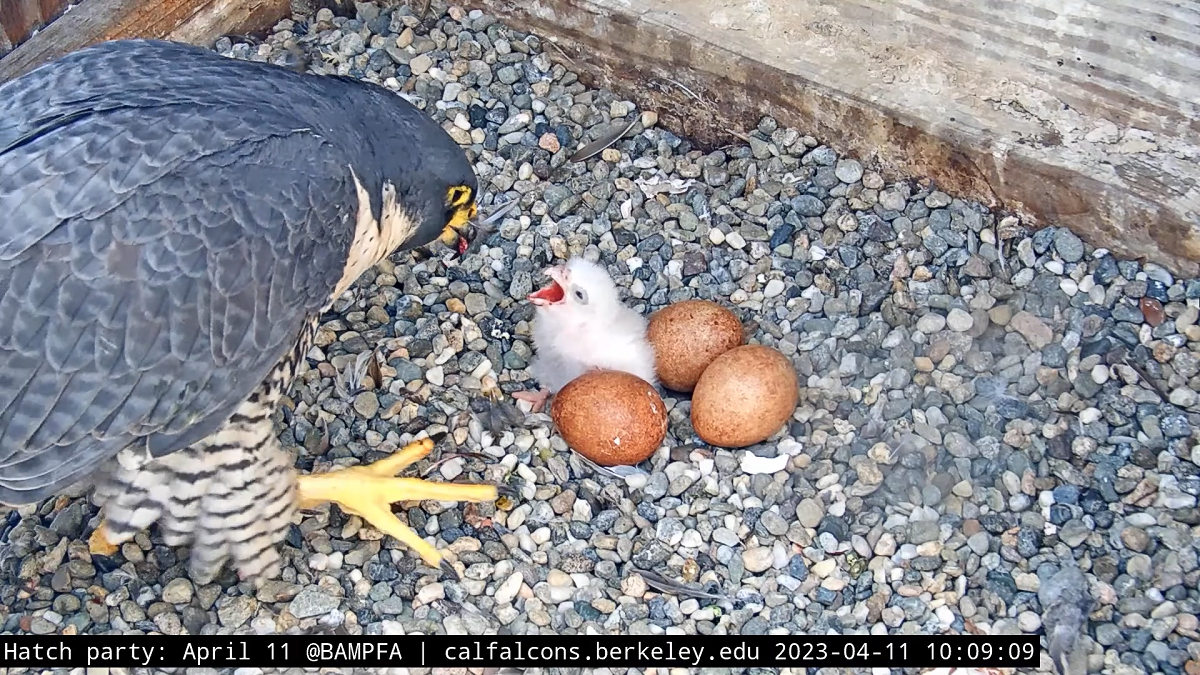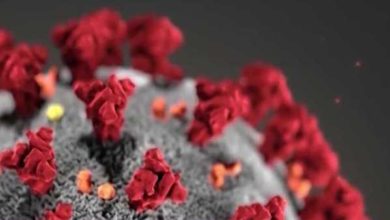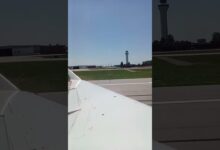

The raptor world is eagerly watching UC Berkeley's peregrine falcon live webcam Wednesday after two eggs hatched Monday and Tuesday — and there are still two left to go. The falcon family is perched atop the Campanile, or the university's clock tower, with parents Annie and Lou taking turns keeping the eggs and newest chicks warm. Typically, Annie hatches three eggs. If all eggs hatch, it would be a first for Annie, who Tim Stroshane says has been hatching eggs on top of Campanile since 2017. Stroshane is a volunteer with Cal Falcons. He and his wife began volunteering for recovery groups in the 1970s when the couple first worked with the Predatory Bird Research Group at UC Santa Cruz.He told our sister station KCRA that during his time volunteering with the group, peregrines were "few and far between.""It's been a thrill of my adult life that these birds have made it back and that my wife Jan and I are able to contribute to monitoring their behavior," Stroshane said.As the world waits for the next egg to hatch, Stroshane says the predatory raptor species was actually on the brink of extinction not too long ago. In the 1970s, the United States government banned the pesticide DDT, one of the primary reasons for the peregrine falcon's near extinction. Since then, Stroshane said people have worked to manage the recovery of the species' population. "And what we're seeing with the arrival of the nesting pair at the Campanile is some of the successes of that management effort," he said. The three webcams atop the Campanile, which are available to the public 24/7, are also an important addition for scientists to study the birds. "It gives people, it gives the public, the scientists, a window into the lives of these birds. And it's a remarkable thing," Stroshane said.The peregrine falcon is the fastest animal on Earth, able to reach diving speeds that exceed 200 miles per hour. Stroshane said the bird relies on an element of surprise due to the speeds it can attain. Although humans may be mesmerized by peregrine falcons' speed, Stroshane said there's another element most people can relate to — the way the birds work as a family unit. The webcam is able to give the public an inside look at the division of labor between males and females, and the way they share duties. "The male will sometimes brood the eggs, you know, lay on the eggs and the female will perhaps take a break and go hunt and bring food back and then feed the chicks and then reassume the brooding duties," he said.
The raptor world is eagerly watching UC Berkeley's peregrine falcon live webcam Wednesday after two eggs hatched Monday and Tuesday — and there are still two left to go.
The falcon family is perched atop the Campanile, or the university's clock tower, with parents Annie and Lou taking turns keeping the eggs and newest chicks warm.
Typically, Annie hatches three eggs. If all eggs hatch, it would be a first for Annie, who Tim Stroshane says has been hatching eggs on top of Campanile since 2017.
This content is imported from YouTube.
You may be able to find the same content in another format, or you may be able to find more information, at their web site.
Stroshane is a volunteer with Cal Falcons. He and his wife began volunteering for recovery groups in the 1970s when the couple first worked with the Predatory Bird Research Group at UC Santa Cruz.
He told our sister station KCRA that during his time volunteering with the group, peregrines were "few and far between."
"It's been a thrill of my adult life that these birds have made it back and that my wife Jan and I are able to contribute to monitoring their behavior," Stroshane said.
As the world waits for the next egg to hatch, Stroshane says the predatory raptor species was actually on the brink of extinction not too long ago.
In the 1970s, the United States government banned the pesticide DDT, one of the primary reasons for the peregrine falcon's near extinction.
Since then, Stroshane said people have worked to manage the recovery of the species' population.
"And what we're seeing with the arrival of the nesting pair at the Campanile is some of the successes of that management effort," he said.
The three webcams atop the Campanile, which are available to the public 24/7, are also an important addition for scientists to study the birds.
"It gives people, it gives the public, the scientists, a window into the lives of these birds. And it's a remarkable thing," Stroshane said.
The peregrine falcon is the fastest animal on Earth, able to reach diving speeds that exceed 200 miles per hour.
Stroshane said the bird relies on an element of surprise due to the speeds it can attain.
Although humans may be mesmerized by peregrine falcons' speed, Stroshane said there's another element most people can relate to — the way the birds work as a family unit.
The webcam is able to give the public an inside look at the division of labor between males and females, and the way they share duties.
"The male will sometimes brood the eggs, you know, lay on the eggs and the female will perhaps take a break and go hunt and bring food back and then feed the chicks and then reassume the brooding duties," he said.
Source link








